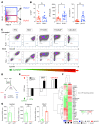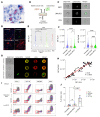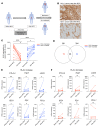BCG therapy downregulates HLA-I on malignant cells to subvert antitumor immune responses in bladder cancer
- PMID: 35503263
- PMCID: PMC9197524
- DOI: 10.1172/JCI145666
BCG therapy downregulates HLA-I on malignant cells to subvert antitumor immune responses in bladder cancer
Abstract
Patients with high-risk, nonmuscle-invasive bladder cancer (NMIBC) frequently relapse after standard intravesical bacillus Calmette-Guérin (BCG) therapy and may have a dismal outcome. The mechanisms of resistance to such immunotherapy remain poorly understood. Here, using cancer cell lines, freshly resected human bladder tumors, and samples from cohorts of patients with bladder cancer before and after BCG therapy, we demonstrate 2 distinct patterns of immune subversion upon BCG relapse. In the first pattern, intracellular BCG infection of cancer cells induced a posttranscriptional downregulation of HLA-I membrane expression via inhibition of autophagy flux. Patients with HLA-I-deficient cancer cells following BCG therapy had a myeloid immunosuppressive tumor microenvironment (TME) with epithelial-mesenchymal transition (EMT) characteristics and dismal outcomes. Conversely, patients with HLA-I-proficient cancer cells after BCG therapy presented with CD8+ T cell tumor infiltrates, upregulation of inflammatory cytokines, and immune checkpoint-inhibitory molecules. The latter patients had a very favorable outcome. We surmise that HLA-I expression in bladder cancers at relapse following BCG does not result from immunoediting but rather from an immune subversion process directly induced by BCG on cancer cells, which predicts a dismal prognosis. HLA-I scoring of cancer cells by IHC staining can be easily implemented by pathologists in routine practice to stratify future treatment strategies for patients with urothelial cancer.
Keywords: Bacterial infections; Cancer; Immunology; MHC class 1; Oncology.
Conflict of interest statement
Figures







Similar articles
-
Systemic versus localized Bacillus Calmette Guérin immunotherapy of bladder cancer promotes an anti-tumoral microenvironment: Novel role of trained immunity.Int J Cancer. 2024 Jul 15;155(2):352-364. doi: 10.1002/ijc.34897. Epub 2024 Mar 14. Int J Cancer. 2024. PMID: 38483404
-
A Phase 1/2 Single-arm Clinical Trial of Recombinant Bacillus Calmette-Guérin (BCG) VPM1002BC Immunotherapy in Non-muscle-invasive Bladder Cancer Recurrence After Conventional BCG Therapy: SAKK 06/14.Eur Urol Oncol. 2022 Apr;5(2):195-202. doi: 10.1016/j.euo.2021.12.006. Epub 2022 Jan 7. Eur Urol Oncol. 2022. PMID: 35012889 Clinical Trial.
-
CREST: phase III study of sasanlimab and Bacillus Calmette-Guérin for patients with Bacillus Calmette-Guérin-naïve high-risk non-muscle-invasive bladder cancer.Future Oncol. 2024 May;20(14):891-901. doi: 10.2217/fon-2023-0271. Epub 2024 Jan 8. Future Oncol. 2024. PMID: 38189180
-
[Genetic and immunologic determinants of intravesical BCG therapy in non-muscle-invasive urothelial bladder cancer].Postepy Hig Med Dosw (Online). 2014 Mar 20;68:291-300. doi: 10.5604/17322693.1094714. Postepy Hig Med Dosw (Online). 2014. PMID: 24662797 Review. Polish.
-
Predicting Response to Intravesical Bacillus Calmette-Guérin Immunotherapy: Are We There Yet? A Systematic Review.Eur Urol. 2018 May;73(5):738-748. doi: 10.1016/j.eururo.2017.10.003. Epub 2017 Oct 18. Eur Urol. 2018. PMID: 29055653
Cited by
-
The Role of Tumor and Host Microbiome on Immunotherapy Response in Urologic Cancers.J Cancer Immunol (Wilmington). 2024;6(1):1-13. doi: 10.33696/cancerimmunol.6.078. J Cancer Immunol (Wilmington). 2024. PMID: 38846356 Free PMC article.
-
[A pan-cancer analysis of PYCR1 and its predictive value for chemotherapy and immunotherapy responses in bladder cancer].Nan Fang Yi Ke Da Xue Xue Bao. 2025 Apr 20;45(4):880-892. doi: 10.12122/j.issn.1673-4254.2025.04.24. Nan Fang Yi Ke Da Xue Xue Bao. 2025. PMID: 40294939 Free PMC article. Chinese.
-
Autoimmunity and Carcinogenesis: Their Relationship under the Umbrella of Autophagy.Biomedicines. 2023 Apr 8;11(4):1130. doi: 10.3390/biomedicines11041130. Biomedicines. 2023. PMID: 37189748 Free PMC article. Review.
-
A Phase II Study of Durvalumab for Bacillus Calmette-Guerin (BCG) Unresponsive Urothelial Carcinoma In Situ of the Bladder.Clin Cancer Res. 2023 Oct 2;29(19):3875-3881. doi: 10.1158/1078-0432.CCR-23-0354. Clin Cancer Res. 2023. PMID: 37505486 Free PMC article. Clinical Trial.
-
Tumor cell membrane-based vaccines: A potential boost for cancer immunotherapy.Exploration (Beijing). 2024 Mar 28;4(6):20230171. doi: 10.1002/EXP.20230171. eCollection 2024 Dec. Exploration (Beijing). 2024. PMID: 39713208 Free PMC article. Review.
References
Publication types
MeSH terms
Substances
Grants and funding
LinkOut - more resources
Full Text Sources
Medical
Molecular Biology Databases
Research Materials

